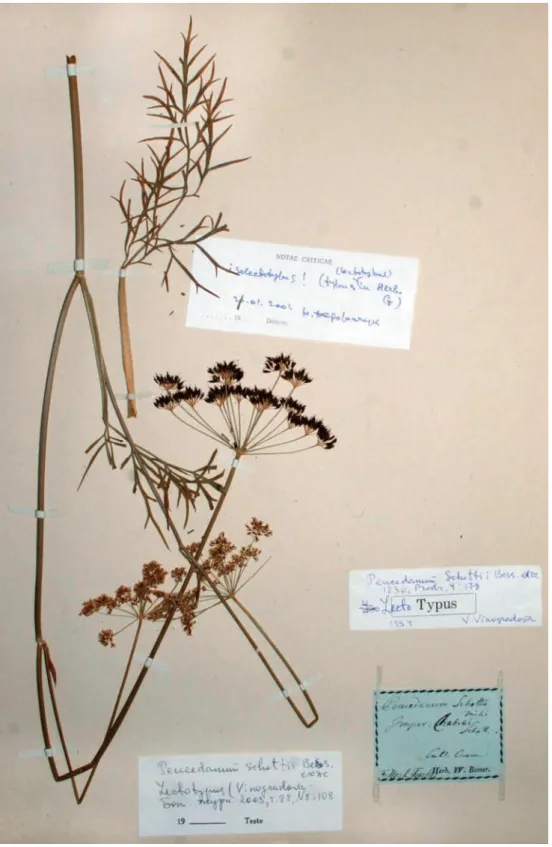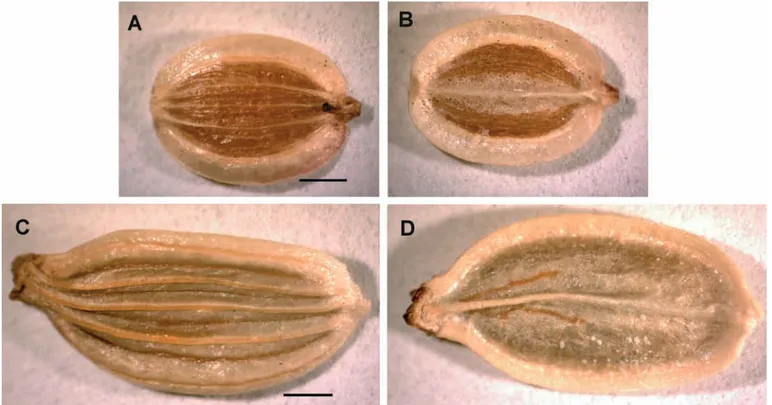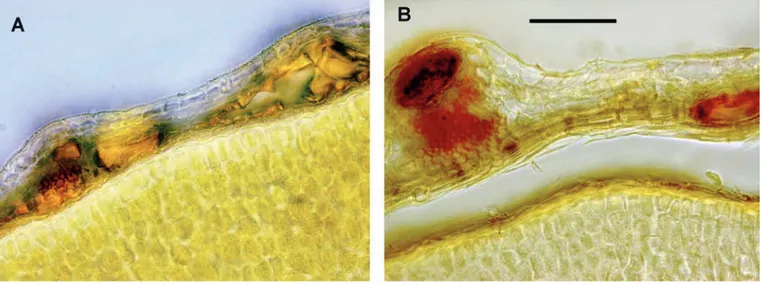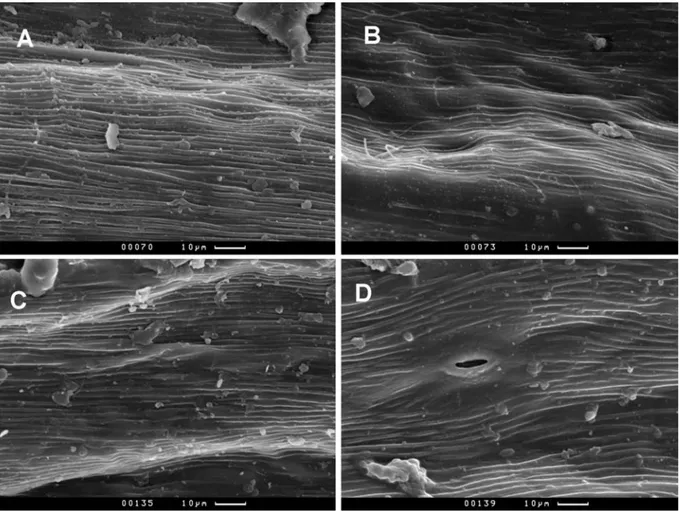Dichoropetalum schottii: examination of the type specimen, distribution
and comparison with D. carvifolium-chabraei (Apiaceae)
Eugene V. Kljuykov
1*, Tatiana A. Ostroumova
1, Fabio Conti
2,
Patricia M. Tilney
31 Botanical Garden, Lomonosov Moscow State University, Russian
Federation
E-mail: [email protected]
2 Scuola di Bioscienze e Medicina Veterinaria, Università di
Camerino - Centro Ricerche Floristiche dell’Appennino, Parco Nazionale del Gran Sasso e Monti della Laga, S. Colombo, 67021 Barisciano (�Q), Italia
E-mail: [email protected]
3 Department of Botany and Plant Biotechnology, University of
Johannesburg, P.O. Box 524, �uckland Park, 2006 Johannesburg, South Africa
E-mail: [email protected]
*Corresponding author: [email protected]
© 2015 Eugene V. Kljuykov, Tatiana A. Ostroumova, Fabio Conti, Patricia M. Tilney
Received: 28 August 2015
Accepted for publication: 12 October 2015
Abstract - The lectotype and isolectotype specimens of
Peuce-danum schottii, based on plants originally cultivated in Cremenets
Botanical Garden, have been studied in detail. The geographic pro-venance of the plants is unknown but they are identical to natural populations in Albania, Bosnia & Herzegovina, Croatia, France, Greece, Italy, Montenegro and Serbia. The valid name for this plant is therefore Dichoropetalum schottii. It differs from a related spe-cies, D. carvifolium-chabraei, in having glabrous umbel rays, white (not yellow) petals, long styles and solitary secretory ducts in fruit valleculae.
Key words: Dichoropetalum, Peucedanum, nomenclature,
anat-omy, micromorphology.
Riassunto - Dichoropetalum schottii: esame del tipo,
distribu-zione e confronto con D. carvifolium-chabraei (Apiaceae). Il lectotipo e l’isolectotipo di Peucedanum schottii, basati su piante originariamente coltivate nell’Orto Botanico di Cremenets, sono stati studiati approfonditamente. La provenienza geografica del campione è sconosciuta. Il tipo corrisponde alle popolazioni di Alba-nia, Bosnia & Herzegovina, Croazia, Francia, Grecia, Italia, Monte-negro e Serbia, identificate con Dichoropetalum schottii. Differisce dall’affine D. carvifolium-chabraei per i raggi glabri dell’ombrella, i petali bianchi (non gialli), gli stili corti e canali secretori solitari nelle vallecole del frutto.
Parole chiave: Anatomia, Dichoropetalum, micromorfologia,
nomenclatura, Peucedanum.
INTRODUCTION
The genus Dichoropetalum, described by Fenzl (1842), had for a long time been neglected, and was only recently reinstated (Pimenov et al., 2007). It now contains 38 species from eastern, western and southern Europe, North Africa and Southwestern Asia, the centre of diversity being Turkey. A few local Mediterranean endemics and two widespread species, D. schottii (Bess.) Pimenov & Kljuykov and
D. carvifolium-chabraei (Crantz) Soldano, Galasso
& Banfi, have been reported for Europe, their range partly overlapping but with D. schottii growing fur-ther south than D. carvifolium-chabraei. The latter had been known under the name Peucedanum
car-vifolia Vill. nom. illeg. The nomenclatural problem
was solved by Soldano et al. (2005) and Banfi et al. (2011). However, for D. schottii, some questions re-mained unanswered. The species was described as
Peucedanum schottii by Besser (Candolle, 1830),
based on a herbarium specimen of a plant originally cultivated in Cremenets. The geographic provenan-ce of the plant material was unknown, being speci-fied in the description as Vohlynia et Podolia (now Ukraine). In subsequent “Floras” (e.g., Thellung, 1925; Shishkin, 1951; Tutin, 1968; Hartvig, 1986), Ukraine was mentioned as part of the distribution area of D. schottii. However, D. schottii has never been collected in natural habitats in Ukraine or nei-ghbouring countries, its distribution being limited to South Europe, from Serbia to France. In Vohlynia and Podolia, only D. carvifolium-chabraei is pre-sent. Vinogradova (2004) in “Flora of Eastern Euro-pe” placed Peucedanum schottii in synonymy with P.
carvifolium. In addition, P. schotti was described as a
plant having flowers with ochroleucous petals whe-reas the petals are pure white in the South European species, and yellowish or greenish in D.
carvifolium-chabraei. Thus there is uncertainty as to whether the Peucedanum schottii type specimens are identical to
the South European species. If the type belongs to D.
carvifolium-chabraei, the South European species
should be given a new name. The lectotype in G-DC was designated by Hartvig (1986); the isolectotype with the label “Cult. Crem. Besser” is in LE (Vino-gradova, 2003).
MATERIALS AND METHODS
We have examined the photo of the lectotype in G-DC, the isolectotype of P. schottii in LE, visited its natural ha-bitats in Italy and Montenegro, and studied numerous her-barium sheets in LE, MW, FL and BP (acronyms follow Thiers, continuously updated). We have also analyzed fruit anatomy and micro-morphology in D. schottii and
D. carvifolium-chabraei.
RESULTS
Type specimens of Peucedanum schottii
The lectotype of Peucedanum schottii in G-DC is presented by leaf fragments and some mature fruits with solitary secretory ducts in valleculas and long styles. The isolectotype of Peucedanum schottii (Fig. 1) in LE was collected at the stage of flowers and young fruits,
without roots. Besser mentioned the following in the protologue: “terete stems, pinnate leaves with narrow linear segments, no involucelle bracts, glabrous umbel rays, solitary vallecular secretory ducts and light-yellow petals”. In our anatomical cross sections of young fruits, we confirmed the presence of solitary secretory ducts. Stem, leaf, umbel and fruit characters of the type speci-mens match those of the South European species occur-ring in natural populations. Besser may have described the petal colour of a dried herbarium specimen because the fresh petals are white. We have noticed that when dried, the white petals of D. schottii become yellowish. The natural populations are therefore identical to the type specimens of P. schottii.
Fruit morphology, anatomy and micromorphology of
Dichoropetalum carvifolium-chabraei and D. schottii
Morphology and anatomy (Figs. 2-4): fruits separa-te into mericarps; elliptic; with carpophore bifid to the base; mericarps homomorphic; glabrous; strongly com-pressed dorsally; dorsal ribs filiform; marginal ribs nar-rowly winged; calyx teeth obsolete; stylopodia conical; styles recurved; exocarp cells small; commissure broad, exocarp interrupted near edges of marginal ribs; inner fibrous mesocarp present; mesocarp parenchyma not li-gnified dorsally but with lili-gnified pitted walls in margi-nal ribs; vascular bundles compact; situated in primary rib bases; vittae vallecular and commissural; rib secre-tory ducts small or large, present in all ribs; endocarp not lignified; endosperm flat, slightly convex or slightly concave on commissural side; embryo with two cotyle-dons.
Micromorphology (Fig. 5)
On dorsal ribs cell borders indistinct, surface smooth or undulate, on valleculae and marginal ribs cell borders indistinct or slightly distinct, cells arranged at random, isodiametric, anticlinal walls straight, raised, outer peri-clinal walls slightly concave, cuticula striate or sparsely striate with straight striae; stomata few, cuticula around stomata smooth. Epicuticular secretions scanty, as thin discontinous layer.
Diagnostic characters are listed in Tab. 1.
DISCUSSION
The type specimen of Peucedanum schottii was culti-vated from seed, presumably originally collected in South Europe. It is identical to natural populations, and the na-me Dichoropetalum schottii clearly applies to the South European species. Dichoropetalum carvifolium-chabraei and D. schottii have similar underground organs and are very much alike in habit. The petals, pure white in D.
schottii, and greenish-yellowish in D. carvifolium-cha-braei, become yellowish when dried. There are, however,
several reliable diagnostic characters (Tab. 1) that enable us to regard the two plants as separate species.
Taxonomy
Dichoropetalum carvifolium-chabraei (Crantz)
Sol-dano, Galasso & Banfi,
Atti Soc. it. Sci. nat. Mu-
Sci. nat.
Mu-seo civ. Stor. nat. Milano, 152(II): 89. 2011
≡Selinum carvifolium-chabraei Crantz, Inst. Rei Herb.,
2: 126. 1766 ≡ Seseli carvifolia L. Sp. Pl.: 260. 1753, p.p. (excl. syn. Rivin.); L. Sp. Pl. ed. II: 350. 1762, p.
Fig. 2 - Mericarps. A, B) Dichoropetalum carvifolium-chabraei; C, D) D. schottii; A, C) dorsal side; B, D) commissural side. Scale bars = 1 mm.
Fig. 3 - Mericarp transections, schematic. A) mature mericarp of Dichoropetalum carvifolium-chabraei, B) mature mericarp of D.
schottii; C) immature mericarp of isolectotype of D. schottii. Scale bar = 1 mm.
Abbreviations: cav) cavity, dc) commissural secretory duct, dr) rib secretory duct, dv) vallecular secretory duct, es) endosperm, ex) exocarp, he) hypendocarp, lp) lignified pitted parenchyma, vb) vascular bundle.
Fig. 5 - Fruit micromorphology. Mericarps. A, B) Dichoropetalum carvifolium-chabraei; C, D) D. schottii; A, C) dorsal rib; B, D) vallecula.
Tab. 1 - Diagnostic characters of Dichoropetalum carvifolium-chabraei and D. schottii.
Character D. carvifolium-chabraei D. schottii
Umbel rays Scabrous Glabrous
Petal colour Yellowish or greenish White when fresh, yellowish when dry Style length Short, ca. 1 mm, slightly longer than
stylopodium Long, ca. 2 mm, 2-3 times longer than stylopodium
Fruit length, mm 4-5 5-7.5
Fruit width, mm 2.5-3.5 4-6
Vallecular secretory ducts Several Solitary
Rib secretory ducts Small Small to large
min. p. ≡ Peucedanum carvifolia Vill., Prosp. Hist. Pl. Dauphiné: 25. 1779 [& Hist. Pl. Dauphiné 2: 638. 1787] nom. illeg. ≡ Dichoropetalum carvifolia Pimenov & Kljuykov, Willdenowia, 37, 2: 478. 2007 nom. illeg. ≡
Selinum chabraei Jacq., Fl. �ustriac. 5: 72.1778 [& in
Murray, Syst. Veg., ed. 14: 279. 1784] nom. illeg. Lec-totype (designated by Frey 1989: 280): [icon] Selinum
carvifolia-chabraei Crantz, Stirp. �ustr. Fasc. 3, t. 3, fig.
2. 1767.
= Selinum podolicum Bess., Prim. Fl. Galic. 2: 392. 1809 ≡ Peucedanum podolicum (Bess.) Eichw., Naturhist. Skizze: 155. 1830
= Peucedanum euphimiae Kotov, Ukrainsk. Bot. Zhurn. 1, 2: 278. 1940. Holotype: “Inter frutices in de-cliviis calcareis et cretaceis in parte orientali Ucrainae” (KW).
Distribution. – Austria, Belgium, Bosnia &
Hungary, Italy, Luxembourg, Moldavia, the Netherlands, Romania, Russia, Serbia, Slovakia, Spain, Switzerland, Ukraine.
Dichoropetalum schottii (Bess.) Pimenov &
Kljuyk-ov, Willdenowia, 37, 2: 480. 2007 ≡ Peucedanum schottii Bess. in Candolle, Prodr. 4: 178. 1830. Lectotype (desig-nated by Hartvig 1986): G-DC!; isolectotype “Cult. Crem.
Besser” (Vinogradova 2003) (LE!).
= Peucedanum petraeum W.D.J.Koch, Syn. Fl. Germ., ed. 1: 304. 1837 ≡ Peucedanum schottii var. petraeum W.D.J.Koch, Syn. Fl. Germ., ed. 2: 334. 1843 ≡
Peuceda-num schottii subvar. petraeum (W.D.J.Koch) Burnat, Fl.
Alp. Marit. 4: 206. 1906. – Holotype: Italia “In rupibus et locis asperis saxosis (zwischen Triest u. Fiume an Felsen der neuen Straße), Noe” (W; isotype: G).
Distribution. – Albania, Bosnia & Herzegovina,
Croa-tia, France, Greece, Italy, Montenegro, Serbia.
The main synonyms are mentioned here; for the full list of synonyms see Pimenov et al. (2007).
Acknowledgements
This work is supported by grants from the Russian Foundation for Basic Research (No 13-04-00648 and 15-29-02748). We are grateful to the curators of BP, FL, LE, MW herbaria for use of their facilities. We thank Laurent Gautier (G) for providing us the image of the lectotype of
Peucedanum schottii. SEM studies are performed at the
User Facilities Center of M.V.Lomonosov Moscow State University under financial support of Ministry of Educa-tion and Science of Russian FederaEduca-tion.
REFERENCES
Banfi E., Galasso G. & Soldano �., 2011 – Notes on sys-tematics and taxonomy for the Italian vascular flora. 2. Atti della Società Italiana di Scienze naturali e del
Museo civico di Storia naturale di Milano, 152 (2):
85-106.
Candolle de A.P., 1830 – Prodromus Systematis Naturalis Regni Vegetabilis. V. 4. Sumptibus Sociorum Treuttel
et Würtz, Paris.
Fenzl E., 1842 – Pugillus plantarum novarum Syriae et Tauri occidentalis primus. Wien.
Hartvig P., 1986 – Umbelliferae. In: Mountain flora of Greece. Strid A. & Tan K. (eds.). Cambridge
Univer-sity Press, Cambridge, 1: 655-735.
Pimenov M.G., Kljuykov E.V. & Ostroumova T.�., 2007 – Critical taxonomic analysis of Dichoropetalum,
Johre-nia, Zeravschania and related genera of Umbelliferae-Apioideae-Peucedaneae. Willdenowia 37: 465-502.
doi:10.3372/wi.37.37208
Shishkin B.K., 1951 – Peucedanum. In: Flora SSSR. Shishkin B.K. & Bobrov E.G. (eds.). Editio
Acade-miae Scientiarum URSS, Moskva & Leningrad, 17:
168-203.
Soldano �., Conti F., Banfi E. & Galasso G., 2005 – No-menclatural novelties (Novità noNo-menclaturali). In: An Annotated Checklist of the Italian Vascular Flora. Conti F., Abbate G., Alessandrini A. & Blasi C (eds.).
Palombi Editori, Roma: 17-22; 27-32.
Thellung �., 1925-26 – Umbelliferae. In: Illustrierte Flora von Mittel-Europa. Hegi G. (ed.). Blackwell
Wissen-schafts-Verlag, München, 5 (2): 926-1537.
Thiers B., 2014 – Index herbariorum: a global directory of public herbaria and associated staff. New York Botani-cal Garden’s Virtual Herbarium. <http://sweetgum. nybg.org/ih/> (retrieved on October 2015).
Tutin T.G., 1968 – Umbelliferae. In: Flora europaea. Tu- Tu-tin T.G., Heywood V.H., Burges N.A., Moore D.M., Valentine D.H., Walters S.M. & Webb D.A. (eds.).
Cambridge University Press, Cambridge, 2: 315-375.
Vinogradova V.M., 2003 – Type specimens of Apiaceae taxa from the East Europe kept in the herbarium of Komarov Botanical Institute (LE). Bot. Zhurn. (St.
Pe-tersburg), 88 (8): 105-111.
Vinogradova V.M., 2004 – Apiaceae Lindl. In: Flore Eu-ropae orientalis. Tsvelev N.N. (ed.). KMK, Moscow-Sanct-Petersburg, 11: 315-437.



